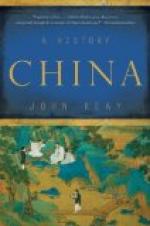The rising of the Yellow Turbans began in 184; all parties, cliques and generals alike, were equally afraid of the revolutionaries, since these were a threat to the gentry as such, and so to all parties. Consequently a combined army of considerable size was got together and sent against the rebels. The Yellow Turbans were beaten.
During these struggles it became evident that Ts’ao Ts’ao with his troops had become the strongest of all the generals. His troops seem to have consisted not of Chinese soldiers alone, but also of Hsiung-nu. It is understandable that the annals say nothing about this, and it can only be inferred from the facts. It appears that in order to reinforce their armies the generals recruited not only Chinese but foreigners. The generals operating in the region of the present-day Peking had soldiers of the Wu-huan and Hsien-pi, and even of the Ting-ling; Liu Pei, in the west, made use of Tanguts, and Ts’ao Ts’ao clearly went farthest of all in this direction; he seems to have been responsible for settling nineteen tribes of Hsiung-nu in the Chinese province of Shansi between 180 and 200, in return for their armed aid. In this way Ts’ao Ts’ao gained permanent power in the empire by means of these troops, so that immediately after his death his son Ts’ao P’ei, with the support of powerful allied families, was able to force the emperor to abdicate and to found a new dynasty, the Wei dynasty (A.D. 220).




